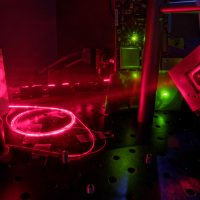PI and coordinator: Sylvain Barbay, CNRS Director of Research, sylvain.barbay@c2n.upsaclay.fr, website, linkedin
PhD student: Amir Masoninia, amir.masominoa@c2n.upsaclay.fr, linkedin
and Abderrahim Ramdane, Guy Aubin and Farah Amar (ultrafast spike coding implementations), Isabelle Sagnes and Grégoire Beaudoin (MOCVD Growth), clean room staff (nanofabrication).
The Center of Nanoscience and Nanotechnology (C2N), is a laboratory specialized in micro-nanosciences hosting a world-class nanofabrication platform. Photonics is a strong axis of research atthe C2N with activities spanning from basic physics to demonstrators and devices. C2N is the coordinating partner of Anaconda. It will contribute to the project in the design, nanofabrication and characterization of ultrafast spiking neuron arrays used for delay-based and spatiotemporal reservoir computing architectures studied together will the partners. C2N will also study ultrafast spike coding strategies and their implementations.
https://www.c2n.universite-paris-saclay.fr/fr/
PI: Daniel Brunner, CNRS senior Researcher: daniel.brunner@femto-st.fr, Twitter, website
PhD student (co-directed with CERCO): Ria Talukder, ria.talukder@femto-st.fr, linkedin
The Femto-ST partner (PI : Daniel Brunner, CNRS Researcher) is a pionnier in the field of Photonics RC and developed the first optoelectronic reservoir computer [8], the first laser RC [4] and the first large-scale spatio-temporal photonic RC implementing reinforcement learning [2]. Femto-ST will bring its expertise in photonic RC, photonic nonlinear networks and learning concepts to the consortium.
 CERCO
CERCO
PI: Simon Thorpe, CNRS Director of Research, simon.thorpe@cnrs.fr
The CerCo partner explores the human visual system and its connections to the brain visual processing. It studies cognitive functions such as space perception, object recognition, conscious and mental states by mixing clinical and fundamental research. The partner has a world leading and unique expertise in computational and theoretical neurosciences, being at the origin of the discovery of the importance of the role of neuron spike timings in the brain visual processing.



